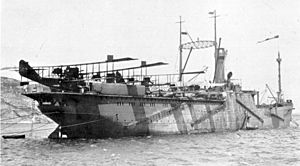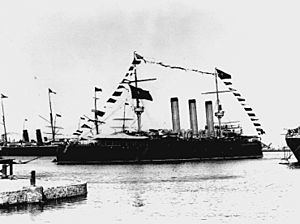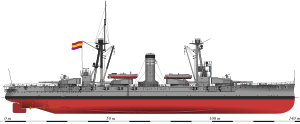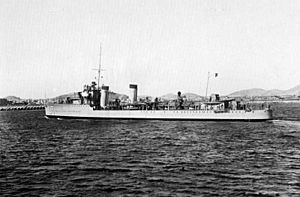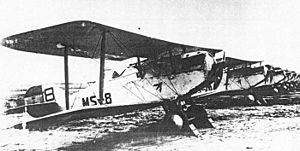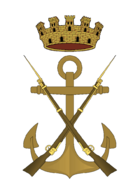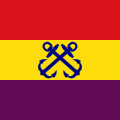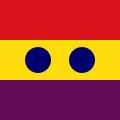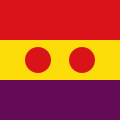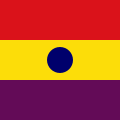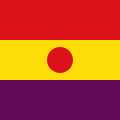Spanish Republican Navy facts for kids
Quick facts for kids Spanish Republican Navy |
|
|---|---|
| Marina de Guerra de la República Española | |
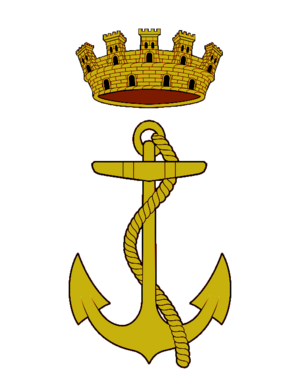
Emblem
|
|
| Active | 1931 – 1939 |
| Country | |
| Branch | Spanish Republican Armed Forces |
| Type | Navy |
| Role | Maritime and coastal defence |
| Engagements | Insurrection in Asturias Spanish Civil War |
| Commanders | |
| Notable commanders | Miguel Buiza Fdez.-Palacios, Luis González de Ubieta, Eduardo Armada Sabau, Tomás de Azcárate, Antonio Azarola y Gresillón, Camilo Molins Carreras, Fernando Barreto Palacios, Joaquín de Eguía y Unzueta, José García Barreiro, Diego de Marón Jordán, Fernando Navarro Capdevila, Luis Núñez de Castro Márquez, José Núñez Rodríguez, Manuel Núñez Rodríguez, Pedro Prado Mendizábal, José María Sánchez Ferragut, Juan Sandalio Sánchez Ferragut, Luis Sánchez Pinzón, Carlos Soto Romero |
| Insignia | |
| Naval ensign and Jack |  |
| Rank flag of the Captain General of the Fleet |  |
| Rank flag of the Admiral of the Fleet |  |
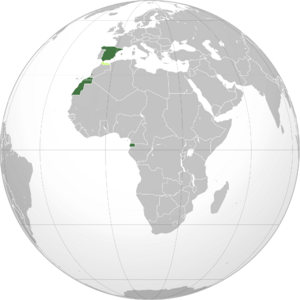
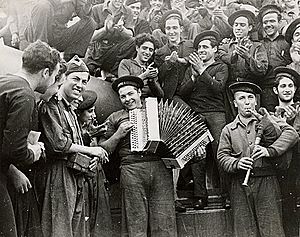
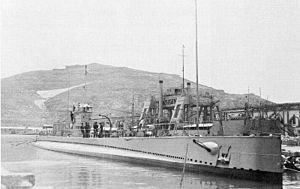
The Spanish Republican Navy was the navy of the Second Spanish Republic. This was the official government of Spain from 1931 to 1939. The navy was a key part of the Spanish Republican Armed Forces. Its main job was to protect Spain's coasts and seas.
Contents
The Spanish Republican Navy changed a lot during its short life. It had two main periods. The first was before the coup in July 1936. The second was after the coup, during the Spanish Civil War.
Early Years of the Republic (1931–1936)
Spain had a large navy from its past as a colonial power. But by the 1930s, many young military officers felt the navy was too big and old-fashioned. They wanted a smaller, more modern navy. This new navy would better fit Spain's needs at the time.
Ramón Franco, an Air Force officer, believed Spain's small colonies did not need a huge navy. He thought the navy's main jobs should be policing harbors and preventing smuggling.
Most senior navy officers liked the old system. They enjoyed the benefits and respect that came with their positions. They did not like the changes made by Manuel Azaña, the new Minister of War. Azaña wanted to modernize the military and cut costs.
The new government also appointed Santiago Casares Quiroga, a civilian, as Minister of the Navy. Many traditional officers did not like this. They felt he did not understand the navy.
The Republic tried to gain support from some officers. But Azaña's way of dealing with conservative officers caused a lot of distrust. Military reforms began quickly. These included changing how officers were promoted. They also reduced the number of high-ranking officers.
In the 1930s, Fascism became popular in Europe. Some parts of the Spanish military were drawn to this idea. By 1935, a secret group of pro-fascist officers, the Unión Militar Española (UME), grew strong. They openly opposed the Republic.
To fight this, officers like Eugenio Rodríguez Sierra helped create the Unión Militar Antifascista (UMA). This group later joined with another, the Unión Militar Republicana (UMR). Together, they formed the Unión Militar Republicana Antifascista (UMRA). This group had a big impact on lower-ranking navy members. It made them oppose the conservative views of their senior officers.
The Civil War (1936–1939)
The military coup in July 1936 greatly damaged the Spanish Republican Armed Forces. The military split into two sides: those who joined the rebels and those loyal to the government. The coup failed in major cities like Madrid and Barcelona. This led to a full-scale war.
The main naval bases of the Spanish Republican Navy were Ferrol, Cádiz, and Cartagena. The rebels tried to take control of the navy. But their messages were not sent in code. This allowed most ship crews to be warned.
As a result, most crews took control of their ships. They arrested their officers. This meant most of the Spanish Navy's ships stayed loyal to the Republic. However, many experienced officers were jailed or killed. This made the loyalist navy less effective.
The rebellion succeeded in parts of northern and southern Spain. Important bases like Ferrol and Cádiz fell to the rebels. Warships being built, like the heavy cruiser Canarias, were seized. They were quickly put into use by the rebels.
Even though the Republic controlled most of the coast and had many ships, the navy was not very effective early in the war. Many experienced commanders joined the rebels. Also, the crew committees that took over the ships struggled with coordination.
Later in 1936, Defence Minister Indalecio Prieto ended the crew committees. This was part of his plan to reorganize the Republican Armed Forces.
Nazi Germany and Fascist Italy strongly supported General Franco's rebel forces. This made it hard for the Spanish Republican Navy to block the Strait of Gibraltar. On August 5, 1936, the "Convoy de la victoria" brought 2,500 rebel troops from Spanish Morocco to Spain. They broke the republican blockade.
On August 7, the battleship Jaime I and cruiser Libertad attacked Algeciras. They damaged rebel ships. But German and Italian planes then attacked the Republican fleet. This stopped them from blocking transport ships. German cruisers also patrolled the Strait.
British authorities in Gibraltar and Tangier were not friendly to the Republic. They refused to sell fuel to Republican ships. They also denied the Republican Navy use of Tangier harbor. But they allowed supplies for German planes in Spanish Morocco. By late September, the Republic had lost control of the waters between Morocco and Spain.
After this, the Republican Navy had to operate from Málaga and Cartagena. They could not use the facilities in Gibraltar and Tangier. Their planes could not stop the massive airlift of rebel troops from Spanish Morocco. This was the world's first long-range combat airlift. It used planes provided by Hitler.
After an operation in the Bay of Biscay in late 1936, the Republican Navy mostly stayed in the Mediterranean Sea. The Basque Auxiliary Navy took over operations in the Bay of Biscay. By late 1937, the northern coast was lost. Many ships were seized by the rebels.
After a defeat at the Battle of Cape Cherchell in September 1937, Luis González de Ubieta became the new fleet commander. President Manuel Azaña was disappointed with the previous commander, Miguel Buiza Fernández-Palacios. Both commanders were young and had been quickly promoted due to a lack of loyal senior officers.
Under Luis González de Ubieta, the Republican Navy focused on protecting supply convoys. They also trained naval officers and crews.
In March 1938, the Republican Navy fought the rebel cruiser Baleares again. This was off Cartagena's coast in the Battle of Cape Palos. Republican destroyers fired torpedoes. Two or three hit Baleares, sinking it. Many rebel sailors were killed or went missing.
The sinking of Baleares was a big victory for the Republic. Luis González de Ubieta received the highest military award. Several ships and their crews also received special honors. Despite this victory, it did not change the overall outcome of the war much.
End of the Civil War
On March 5, 1939, Colonel Segismundo Casado of the Spanish Republican Army led a coup. He formed a new government. On the same day, the Nationalist Air Force bombed Cartagena harbor. This was the main base of the Republican Navy. The destroyer Sanchez Barcaiztegui was sunk.
After the bombing and unrest, Commander Miguel Buiza ordered the main Republican fleet to leave. Cruisers, destroyers, and submarines sailed towards the Algerian coast. They were denied permission to anchor in Oran. They went to Bizerte in Tunisia instead. There, the French authorities seized the fleet. Most of the Spanish Republican sailors and officers were held in a camp.
In the final months of the war, some civilian ships were used by the Republican Navy. They helped evacuate people from cities under attack.
By the end of the war, 8 major Republican warships had been sunk. The remaining ships became part of the Navy of Francoist Spain.
- Battle of Majorca
- Battle of Cape Espartel
- Battle of Cape Cherchell
- Battle of Cape Machichaco
- Battle of Cape Palos
- Bombardment of Almería
- Convoy de la victoria
This section lists the main ships of the Spanish Republican Navy.
Ships from 1931 to 1936
These were the main naval units before the Civil War started.
Battleships
- España-class battleships (16,400 tons, 8 x 305mm guns)
- Alfonso XIII (1915), later renamed España.
- Jaime I (1921).
Cruisers
- Canarias-class heavy cruisers (13,000 tons, 8 x 203mm guns)
- Canarias (building began 1928).
- Baleares (building began 1928).
- Reina Victoria Eugenia-class cruisers (6,500 tons, 9 x 152.4mm guns)
- Republica (1923). Formerly Reina Victoria Eugenia, renamed in 1931.
- Blas de Lezo-class cruisers (6,000 tons, 6 x 152.4mm guns)
- Blas de Lezo (1924), wrecked in 1932.
- Méndez Núñez (1924).
- Almirante Cervera-class light cruisers (9,000 tons, 8 x 152.4mm guns)
- Libertad (1927). Formerly Príncipe Alfonso, renamed in 1931. Flagship of the navy.
- Almirante Cervera (1928).
- Miguel de Cervantes (1930).
- Río de la Plata (1900), used for training.
- Emperador Carlos V (1898), used for exercises until 1933.
Destroyers
- Furor-class destroyers (380 tons, 2 x 75mm guns)
- Proserpina (1898), scrapped in 1931.
- Bustamante-class destroyers (370 tons, 5 x 57mm guns)
- Villaamil (1916).
- Cadarso (1917).
- Alsedo-class destroyers (1,160 tons, 3 x 101.6mm guns)
- Alsedo (1924).
- Velasco (1925).
- Lazaga (1924).
- Churruca-class destroyers (1,600 tons, 5 x 120mm guns)
- First series:
- Sánchez Barcáiztegui (1928).
- José Luis Díez (1929).
- Almirante Ferrándiz (1929).
- Lepanto (1930).
- Churruca (1931).
- Alcalá Galiano (1931).
- Almirante Valdés (under construction).
- Second series (all built in Cartagena):
- Almirante Antequera.
- Almirante Miranda.
- Císcar.
- Escaño.
- Gravina.
- Jorge Juan.
- Ulloa.
- First series:
Other Vessels
- Seaplane carrier Dédalo (1922), decommissioned in 1934.
- Submarine rescue ship Kanguro (1920).
- Training ship Galatea (1922).
- Training ship Juan Sebastián Elcano (1927).
Submarines
- Isaac Peral (1917), decommissioned in 1932.
- A-class submarines (Italian made):
- Narciso Monturiol (A-1) (1917), decommissioned in 1934.
- Cosme García (A-2) (1917), decommissioned in 1931.
- A-3 (1917), decommissioned in 1932.
- B-class submarines (built in Spain):
- B-1 (1922).
- B-2 (1922).
- B-3 (1922).
- B-4 (1923).
- B-5 (1925).
- B-6 (1926).
- C-class submarines:
- Isaac Peral (C-1) (1928).
- C-2 (1928).
- C-3 (1929), sunk by a German submarine in 1936.
- C-4 (1929).
- C-5 (1930).
- C-6 (1930).
Ships from 1936 to 1939 (Civil War)
These were the main ships during the Civil War. All surviving ships became part of the Navy of Francoist Spain.
Battleships
- Jaime I (1921–1937), sunk in 1937 after an explosion.
Cruisers
- Blas de Lezo class
- Méndez Núñez (1924–1963), sailed to Bizerte in March 1939.
- Almirante Cervera class
- Libertad (1927–1965), sailed to Bizerte in March 1939.
- Almirante Cervera (1928–1965).
- Miguel de Cervantes (1930–1964), damaged early in the war, repaired, and sailed to Bizerte in March 1939.
Destroyers
- Alsedo class
- Alsedo (1924–1957), seized by rebels in Cartagena.
- Lazaga (1925–1961), in dockyard at end of war.
- Churruca class
- First series:
- Sánchez Barcáiztegui (1928–1964), sunk in March 1939, later refloated.
- José Luis Díez (1929–1965), joined the Basque Auxiliary Navy. Grounded in Gibraltar in 1938.
- Almirante Ferrándiz (1929–1936), sunk by cruiser Canarias in 1936.
- Lepanto (1930–1957), likely sank the rebel cruiser Baleares. Sailed to Bizerte in March 1939.
- Churruca (1931–1963), seized by rebels in Cartagena.
- Alcalá Galiano (1931–1957), in dockyard at end of war.
- Almirante Valdés (1933–1957), sailed to Bizerte in March 1939.
- Second series:
- Almirante Antequera (1935–1965), sailed to Bizerte in March 1939.
- Almirante Miranda (1936–1970), sailed to Bizerte in March 1939.
- Císcar (1936–1957), bombed and sunk in 1937, refloated and used by rebel navy.
- Escaño (1936–1963), sailed to Bizerte in March 1939.
- Gravina (1936–1963), sailed to Bizerte in March 1939.
- Jorge Juan (1937–1959), sailed to Bizerte in March 1939.
- Ulloa (1937–1963), sailed to Bizerte in March 1939.
- Third series (under construction in Cartagena):
- Liniers.
- General Álava.
- First series:
Submarines
- B-class submarines:
- B-1 (1922–1940), wrecked in 1937.
- B-2 (1922–1952), beached in Cartagena.
- B-3 (1922–1940), beached in Cartagena.
- B-4 (1923–1941), beached in Cartagena.
- B-5 (1925–1936), sunk.
- B-6 (1926–1936), sunk by rebel destroyer Velasco.
- C-class submarines:
- Isaac Peral (C-1) (1928–1950), sunk in 1938, later repaired.
- C-2 (1928–1951), sailed to Bizerte in March 1939.
- C-3 (1928–1936), sunk by a Nazi German submarine.
- C-4 (1928–1946), sailed to Bizerte in March 1939.
- C-5 (1928–1937), fate unknown.
- C-6 (1928–1937), sunk.
- D-class submarines (under construction in Cartagena):
- D-1.
- D-2.
- D-3.
The Aeronáutica Naval was the air force part of the Spanish Republican Navy. It started in 1920 near Barcelona Airport. In September 1936, it joined with the Spanish Republican Army's air arm. This formed the Spanish Republican Air Force.
By 1931, the planes used by the Aeronáutica Naval were getting old. Commander Francisco Moreno Fernández found that their seaplanes could not carry torpedoes or bombs. They were only good for looking around. Some new planes were being built, but they lacked weapon systems.
Officers worried about modernizing the navy. They noted that the newest ships could not carry planes. The seaplane carrier Dédalo was old and slow. It had good repair shops, but it would not last much longer.
On March 7, 1934, something special happened. Juan de la Cierva, who invented the autogyro, landed one on the Dédalo. This was near Valencia. Half an hour later, it took off again. This was the first time a rotorcraft took off and landed on a ship.
The two heavy cruisers being built were supposed to carry seaplanes. But no decision had been made about the type of plane or how to launch it. In 1934, the navy tried to buy four new seaplanes. Only one was delivered.
Older training planes were replaced in 1932. Between 1934 and 1935, the navy tried to update its seaplane fleet. Until 1936, the Aeronáutica Naval also had airships. When the Dédalo was decommissioned in 1934, many officers moved to other parts of the navy.
The Marine Corps: Infantería de Marina
The Spanish Navy Marines (Infantería de Marina) were seen as a "colonial force" early in the Republic. This was because of their role in the unpopular wars in North Africa. Minister of War Manuel Azaña planned to get rid of the marine corps.
However, the Civil War started before they were officially disbanded. In October 1936, the War Ministry changed. The marines in areas loyal to the government were kept. They became part of the Republic's new military. At the Cartagena naval base, the Marine corps mainly guarded ships and naval facilities. They also operated anti-aircraft guns.
Some Republican Marine units also fought on the front lines. The 151 Brigada Mixta was a mixed group of marines. They were led by Commander Pedro Muñoz Caro. Their landing operations were limited. So, these marines mostly fought inland. They supported the Army in battles like Battle of Alfambra and Battle of the Ebro. Photographer Robert Capa took pictures of them in these battles.
Republican Marine Lieutenant Colonel Ambrosio Ristori de la Cuadra was killed during the Siege of Madrid. He was given the highest military award after his death.
The Spanish Republican Navy made some changes to its flags and officer rank symbols. The traditional "executive curl" on uniforms was replaced by a golden five-pointed star. The royal crown on buttons and caps was changed to a "mural crown."
The officer ranks were:
| Rank group | General/flag officers | Senior officers | Junior officers | Officer cadet | ||||||||||||||||||||||||||||||||
|---|---|---|---|---|---|---|---|---|---|---|---|---|---|---|---|---|---|---|---|---|---|---|---|---|---|---|---|---|---|---|---|---|---|---|---|---|
(1931–1936) |
 |
 |
 |
 |
 |
 |
 |
 |
||||||||||||||||||||||||||||
| Vicealmirante | Contraalmirante | Capitán de navío | Capitán de fragata | Capitán de corbeta | Teniente de navío | Alférez de navío | Alférez de fragata
|
|||||||||||||||||||||||||||||
(1931–1936) |
 |
 |
 |
 |
 |
 |
||||||||||||||||||||||||||||||
| Capitán de navío | Capitán de fragata | Capitán de corbeta | Teniente de navío | Alférez de navío | Alférez de fragata
|
|||||||||||||||||||||||||||||||
(1936–1939) |
 |
 |
 |
 |
 |
 |
||||||||||||||||||||||||||||||
| Capitán de navío acting as Vicealmirante |
Capitán de navío acting as Contraalmirante |
Capitán de navío | Capitán de fragata | Capitán de corbeta | Teniente de navío | Alférez de navío | Alférez de fragata | |||||||||||||||||||||||||||||
Ranks of Non-commissioned Officers and Enlisted Sailors
| Rank group | Senior NCOs | Junior NCOs | Enlisted | |||||||||||||||||||||||||||||||||
|---|---|---|---|---|---|---|---|---|---|---|---|---|---|---|---|---|---|---|---|---|---|---|---|---|---|---|---|---|---|---|---|---|---|---|---|---|
(1931–1939) |
 |
 |
 |
 |
 |
 |
 |
|||||||||||||||||||||||||||||
| Subteniente | Subayudante (1931-1935) |
Brigada | Sargento | Cabo | Marinero de primera | Marinero | ||||||||||||||||||||||||||||||
Rank Flags and Pennants
The rank flags and pennants of the Spanish Republican Navy were similar to the old Spanish Navy. The main changes were the colors. The red stripe was replaced with the purple color of the Republican flag.
-
Rank flag of the Minister of the Navy
-
Gallardetón. Captain at Sea Pennant (in command of a naval squadron).
-
Grímpola. Senior Officer Pennant
-
Distintivo de Madrid pennant awarded in 1938 to the vessels that took part in the Battle of Cape Palos
Images for kids
-
Churruca-class destroyer Alcalá Galiano
See also
 In Spanish: Marina de Guerra de la República Española para niños
In Spanish: Marina de Guerra de la República Española para niños
- Spanish Navy
- Basque Auxiliary Navy
- German involvement in the Spanish Civil War
- List of foreign ships wrecked or lost in the Spanish Civil War
- List of retired Spanish Navy ships


